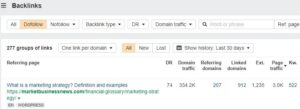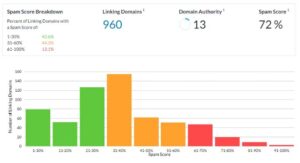What is a PBN backlink? And why shouldn’t you use one?
What is a PBN backlink: Link building is hard. When link building doesn’t work quickly, consider a network of websites to link to. This idea isn’t new. These networks of sites are known as PBNs or private blog networks, and using them is against Google’s guidelines.
Getting to Know PBN Backlinks or Private Blog Networks
Private Blog Network (PBN) backlinks are links from a network of private sites to a target site. PBN sites exist solely to link to the leading site and boost the site’s search engine rankings.

PBNs work because Google’s algorithm uses a site’s link profile to rank a site. Pages on a site also attract links when their content is worth linking to. So, a high number of links indicates a high-quality page.
Of course, if you add your links from a PBN to your leading site, it doesn’t mean your content is high quality. You are trying to fool Google!
That’s why search engines don’t like PBN backlinks. This method was effective in the past for ranking websites, but now Google has become smart in detecting these networks and punishing people who use them.
Should you use PBN backlinks?
Generating PBN backlinks is usually a bad and risky idea. It can lead to significant penalties and a drop in site ranking. This risky link-building strategy is helpful in the short term but will hurt your site in the long term.

How do others build PBNs?
Backlinks are most effective when they come from reputable domains. However, building this type of site is expensive and time-consuming.
For this reason, people who run PBNs use a variety of shortcuts.
First, they build sites on expired domains that are valid because of links created by the previous owner. The new owner adds content to the expired domain and links within these articles.
Adding quality content to a website is expensive. So PBN owners use cheap, low-quality content or, increasingly, content generated by artificial intelligence copywriting tools.
PBN owners also often hide the fact that their sites are relevant. They do this by using different hosts, adding unlinked content to their site, and using different themes to keep the network from being recognized by search engines.
How to Generate PBN Backlinks
There are two main ways to generate PBN backlinks.
The first is to build and use a network to support your site(s).
If you go this route, you keep the network’s link-building secret and selectively link to your websites from the network. If they run well, these networks can be effective for a while.
Another way to get PBN backlinks is to buy them from an existing network. If you go this route, you can get a lot of links in a short period.

However, the people who run these networks often don’t take care of hiding the sites in their network. They may even tell buyers which sites they own! So, it’s unlikely that these networks will provide any particular advantage to link buyers. Most PBN sellers are profiteers who make money by designing low-quality, obvious networks, and tricking buyers into giving them ineffective or low-impact links.
Not all content networks are PBNs
Many people have multiple websites and links between them. This type of link building is not the same as PBNs. As long as you don’t overdo it and the links make sense, there’s nothing wrong with linking between your sites.
A network of websites becomes a PBN when it is designed solely to link to other sites.
Should you build PBN links?
You shouldn’t build PBN links in most cases. Here are some of the pros and cons.
Benefits of PBNs
✔️ PBNs are an easy way to backlink to your site.
✔️ You can choose the exact pages to display the links on.
✔️ Choose optimized anchor text.
✔️ You can build high-volume links.
✔️ If you own a PBN, the links are free for you.
✔️ Link building is helpful in some situations, such as increasing traffic in the short term.

Disadvantages of PBNs
❌ Private link networks can result in heavy penalties from Google.
❌ PBNs are expensive to set up, as you must buy expired domains and add content alongside new ones.
❌ Buyable PBN links are almost worthless or worthless.
❌ Even if you see a ranking boost, there’s still a chance that your rankings will be delisted when Google finds the PBN.
❌ Sites built with PBN links can be challenging to sell.
Google’s stance on PBNs
Google doesn’t like PBN links. While the existing guidelines don’t mention PBNs, they discuss many related actions.
Additionally, Google released an update on link spam in December 2022, targeting links from these sites. The update states that any link “with the intent to manipulate the ranking of a page or site in Google’s search results is likely to be part of link fraud and a violation of Google’s guidelines.”

Finally, if you want to comply with Google’s regulations, don’t use PBN links.
There are many violations of Google’s guidelines and the realities of the SEO industry. For example, paid links are against Google’s policies but are increasingly common (as web admins want to make money) and effective.
But it’s best to avoid PBNs as much as possible. Search engines are adept at detecting these networks, and many sites that have used these links have been penalized and removed from search results.
What happens if you use PBN backlinks?
If you’re looking to buy PBN links, you’ll usually end up with one of three outcomes:
1) You’ll waste your money
The first result is that you won’t see any impact on your rankings. Your site won’t go up or down; it’ll just make your wallet a little lighter!
This usually happens when you have a small number of links on a website that Google knows is part of a PBN. So, the search engine algorithm ignores the link.
Why doesn’t Google penalize these sites?
In many cases, Google ignores links instead of penalizing sites. According to experts in the field, this reduces the impact of negative SEO attacks that use spammy backlinks to lower a competitor’s site’s ranking.

If you can destroy a site’s ranking by pointing a few PBN links to it, then anyone who wants to rank higher than their competitors will use this strategy to their detriment.
Google is unsure if the site is intentionally creating artificial links, so it is fair to ignore the links.
2) You will get a manual penalty
You will get a manual penalty when a human review determines that your backlink profile is unnatural.
If you receive a manual penalty, you will receive a warning in your Google Search Console account. This situation can lead to a drop in ranking and even the removal of your site.
Of course, you can remove PBN links by submitting a disavow file (a spreadsheet containing a list of bad links) to Google. You can then submit an appeal; the search engine will restore your rankings.
3) You’ll See a Ranking Boost
It might be a stretch to say that PBNs never work, but if you build one carefully and use it enough, you can see some positive results (at least in the short term, before Google finds the network).
To prove it, go to the Empire Flipper website and filter the search results by sites that use PBNs. There aren’t many, but they have tens of thousands of monthly visits and thousands of dollars in revenue, which shows how effective private link networks can be in some situations.

The problem is that if you build a site using PBNs, you’re constantly at risk of being penalized by Google. You might see a short-term boost in rankings and revenue, but this can wipe out your rankings and revenue in no time.
Positive results also occur when people build their private link networks. If you buy links from third parties, the chances of these links working are almost zero.
How to Identify PBN Backlinks
So far, we’ve learned that link-building networks are usually bad for your website. The next question is: How do you know if your site gets links from a private network?
You’re probably saying, “I’ve never built a PBN backlink!”
You might have PBN links without generating them yourself for several reasons.
For example:
1. A low-quality link-building service may have created these links.
2. You’ve been the target of a negative SEO attack.
3. The site you’re linking to has been repurposed as part of a PBN.
The good news is that PBN links are usually easy to identify. You need to use SEO tools to view information about the websites linking to you. Then, you can look for unnatural links. For example, you can use Ahrefs to identify bad links.
Simply go to the “Backlinks” report, filter the results for “Dofollow” links, and set the setting to “One link per domain.”

Signs of Bad Links
This will show all the domains that link to your website. Signs in this report that indicate a link is coming from a PBN include:
Suspicious anchor text
Low organic traffic
Large and sudden jumps in organic traffic
Redirects from other domains
Remember that private link networks are often built on expired domains so that they may have high domain authority.
Another option is to use Moz’s tool to find websites with a high Spam Score. This metric indicates the percentage of sites with similar characteristics to those penalized by Google, as seen by Moz.
This is true because good PBNs are intentionally built differently from other PBNs. But you should check out sites with high spam scores.

When you find suspicious links, click on the website for a closer look. Some of the most significant signs of low-quality websites are:
- Bad content
- Suspicious outbound links
- No contact information or details or an “About Us” page
Remove toxic links
You have several options if you find a suspicious link or links during the review process above.
The first is to do nothing.
If you don’t have many suspicious links and your search rankings are stable, Google will likely ignore these links. You can focus on other aspects of SEO (such as creating content or building authoritative links through other methods).

If you have any suspicious links or are concerned that they affect your rankings, you can remove them by creating and uploading a disavow file to Google.
You must create a .txt file containing all the domains from which you want to remove backlinks. Then, upload it to the disavow tool in Google Search Console.
Google will then add the links to its index. According to the company, this process can take a few weeks.